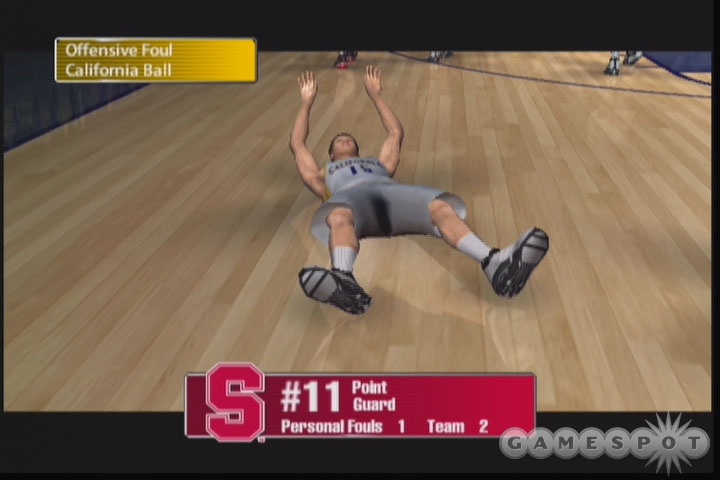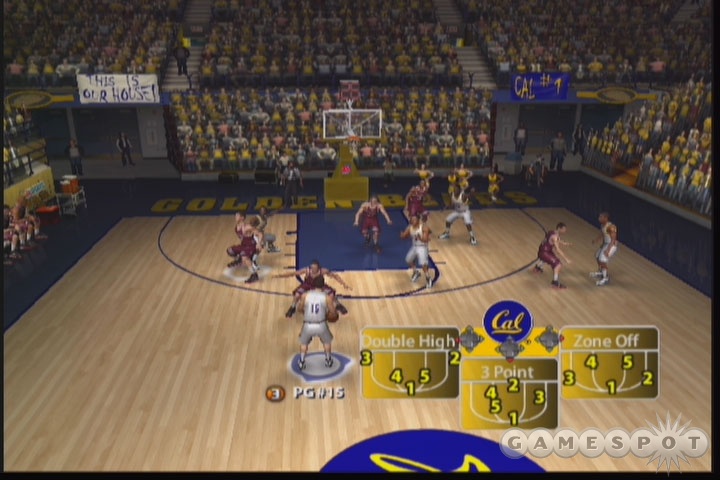Fall is in full swing, and for college sports fans around the country, that means basketball is just around the corner. EA Sports has shipped March Madness 06 nice and early to whet our appetites for the upcoming season. While some great strides have been made since last year, as far as the actual gameplay is concerned, the dynasty mode is still broken, which makes the game feel like an incomplete product.

The newest and most obvious change to the series is the introduction of the lockdown stick, a feature that lets you take any defender so you can play physical, close defense. The way it works is simple. You just walk up to the ball handler and then pull down on the right thumbstick. You'll see your defender press up close to the offensive player, bumping and harassing him as he makes his way up the floor. In practical terms, this lets you shunt the ball away from the basket and toward the sidelines. You'll need to pay close attention to the direction of the ball handler as he changes directions, though. If you don't keep up, you'll find yourself completely out of position, which gives a big advantage to the offense as the ball handler gets free. You can do more than just force the ball handler to one side, however. You can press the trigger buttons to go for a steal, and you can even flop to try to draw an offensive foul. Play your man tight enough and you may draw a five-second violation from him. You can even use the lockdown stick off the ball. If you know which player is the go-to man for the other team, you can use the lockdown stick to deny passes to perimeter players, or you can front the post in the case of big men. This lets you get steals, or it forces players to be farther away from the basket when they catch the ball. In practice, the lockdown stick works great and is fun to use. Having your defender harass ball handlers and denying passing lanes really gives the game a more collegiate feel. When you actually do create turnovers from defensive pressure, it's extremely satisfying.
The lockdown stick meshes well with the introduction of the floor-general feature to defense. In last year's game you could use the D pad to quickly call up six different offensive sets to run. This year you can do the same with defense. If you have a good defensive guard to lock down ball handlers, you can really wreak havoc by calling presses and traps with the defensive floor-general feature. Clicking down on the right thumbstick reveals the spots on the floor where you want to shunt the ball handler to for springing a trap. You have to be careful, though, because if you attempt a trap with poor defenders or against an adept ball handler, he can split the double-team and break out to the open court.
The floor-general feature is still available on offense, of course, and you'll rely on it a lot to break down the various defenses the computer will throw at you. Tossing the ball around or trying to abuse people with the freestyle stick doesn't work as well in March Madness as it does in NBA Live. You'll really need to study how the various offensive plays work to make the most of them. They do work pretty well, though, so it's fun to see your guards break free off backdoor cuts or to see your three-point shooters curl off of staggered screens. The computer will use these same plays against you, so you have to be very aware on defense. That said, we wish it were possible to change out plays on the fly during the game. Unfortunately, the six plays you assign to the floor-general play-calling system at the start of the game are the ones you're stuck with for the duration. There doesn't seem to be a way to swap these out during a game.
While March Madness 06 does a great job at both differentiating itself from pro basketball games and giving itself a real college feel, it once again falls short of the mark in the dynasty mode. Many of the same issues that turned us off last year are still present, such as the fact that you need to squirrel away "discipline points" at the start of each season to suspend players for breaking team rules or for committing other violations. The idea that you can run out of points to punish players is still ludicrous to us. It also seems as though you'll still run into an inordinate number of violations over the course of a given season that you must deal with. We know college athletes aren't saints, but at times it feels as though you have to suspend a player every other week to appease the NCAA in the game. This is particularly painful given that the March Madness 06 rosters only contain 12 players each. Most real-life teams carry 12 or more scholarship players, plus a couple of walk-ons. Finally, a major bug seems to affect dynasty mode as you transition from season to season. All too often you'll find that players inexplicably drop in ratings from one year to the next. While simming a dynasty with California, for example, our star power forward (Leon Powe) dropped from an 85 overall rating to a 73--for no apparent reason--from season one to season two. Playing out dynasties with other teams yielded similarly disturbing results with one or more players. Sure, it's a fact that some players in real life do regress in skill, but the degree to which this occurs in-game seems overexaggerated.
On the positive side, the recruiting aspects of March Madness continue to improve as the series matures, bringing it ever closer to the blissfully fun recruiting mode in NCAA Football. You'll have full control of recruiting in-season, and if you set aside enough points to pursue players during the season, you'll usually be able to fill up your quota of recruits long before the official recruiting season begins in the offseason. You can also play a high school all-star game during the offseason to get a feel for how these players will feel to play when you recruit blue chippers. It's just too bad the flaws in dynasty mode mar the improvements made. The online mode in March Madness has also improved in performance from last year, as it was then pretty choppy. The downside is that there don't seem to be a lot of people online at this point, which makes scaring up a match pretty difficult. Hopefully that will get better as we approach college hoops season.

March Madness also continues to underwhelm in the presentation department. It's looked consistently worse than NBA Live throughout the years, and this year the graphics engine is really beginning to show its age. The player models lack detail, and the crowds in the game look downright primitive. If there's one positive to mention it's that a good deal of work was obviously put into the game's animation. Dunks offer a lot more flair than they have in the past, and you'll see some great collision animations when a guard gets obliterated by a big man on a hard pick in the open court (another reason to be careful when you use the lockdown stick). You'll even see your players get excited and exhort the home crowd when you go on a big run, which is a nice touch. There's also less of an ice-skating look and feel than in NBA Live, but certain issues from that game still linger in March Madness 06. Rebounds will get vacuumed to hands, players recover too quickly off of steals and blocks, and teammates on the wings don't run hard enough on fast breaks. At least the sound in the game is still great. Crowds really get into it when the home team has the momentum, and the familiar announcing crew of Brad Nessler and Dick Vitale anchors the commentary. And even if the game plays contemporary tunes, the soundtrack still (thankfully) involves college bands, instead of the uninvited punk-pop that invaded EA Sports' other college sports franchise.
It's too bad the development team hasn't worked out the issues with the franchise mode in March Madness. Slowly but surely it's starting to lock down a real college feel and atmosphere with the actual gameplay. If you never play dynasty modes and don't mind a somewhat rough-looking game, then March Madness 06 could suit your needs just fine. But if you're looking for a complete package of college basketball, then you'll probably need to look elsewhere.



